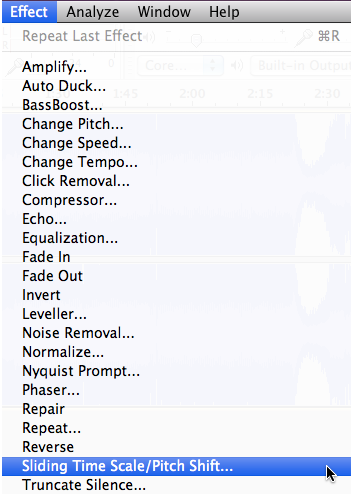
- #SAVED AUDACITY FILE TIME SHIFT HOW TO#
- #SAVED AUDACITY FILE TIME SHIFT PLUS#
- #SAVED AUDACITY FILE TIME SHIFT PROFESSIONAL#
Click on the Track Control Panel of your narration track to select the entire track then choose Effect > Compressor.

You could go through and manually adjust the volume throughout your narration track using the Envelope Tool, but there's an easier way - use Audacity's built-in Compressor effect. Remember, your listeners cannot see you, so having a consistent volume for your narration is important so they will be able to hear and understand everything you are saying.
#SAVED AUDACITY FILE TIME SHIFT PROFESSIONAL#
Unless you are professional narrator or voice-over specialist there are probably level (volume) variations during your narration. When you are happy with the selection, press the Delete key, choose Edit > Delete or press Ctrl + K to delete the selection. Various ways to adjust a selection were discussed in the Editing an Existing Audio File tutorial. Adjust the length of the selection until the edit sounds natural. Press the C key to hear two seconds of audio before, and one second of audio after the selection - this lets you hear what it will sound like after the selection is deleted.
#SAVED AUDACITY FILE TIME SHIFT PLUS#
We want to take out the throat-clearing plus enough space around it to make it sound natural.Īs you can see, the portion to be removed is selected. The image below shows a situation where the speaker paused, cleared his throat and continued with the next sentence. Then listen back to each edit - undo and try again if it does not sound natural. Use Audacity's Cut Preview feature to hear how each edit will sound before you make the edit. Record your narration.ĭo not edit too tightly - the final result should sound natural. When you stop to make a correction, go back to the start of a natural break - sentence or phrase - and start again in a normal voice: once you have tried to edit out your mistakes you will realize the importance of this.Ĭlick the Record button in the Transport Toolbar. In fact you may want to make a few deliberate mistakes so you can practice editing them out later. Do not worry about mistakes, pauses, coughs and similar - we can edit those out later. You are now ready to record the narration. Set the recording device to your microphone in Audacity's Device Toolbar (or on Mac, set the microphone as the default recording source in Apple Audio MIDI Setup). Click on File > Save Project > Save Project or File > Save Project > Save Project As. Start Audacity: a new untitled project window opens. For example: your first step will be to import the audio that you will be recording your narration against you will not need to cut the narration to fit the background track.

If you are overdubbing your narration certain parts of the work flow presented below will change or be eliminated.
#SAVED AUDACITY FILE TIME SHIFT HOW TO#
Otherwise please read the tutorial on overdubbing for details on how to set up Audacity so you can hear both the background track and yourself in your headphones. If you do not need to hear yourself in the headphones you can continue with this tutorial.

Speak in a normal, conversational tone of voice, but also speak clearly and enunciate carefully. While you are talking, try to keep looking in one direction - moving your head left or right, up or down, while you are talking will change the tonal quality of your voice, and may be distracting to your listeners. Finally, try to set up the microphone so that it is 4 to 6 inches away from your mouth. This avoids "popped p's" and other breath effects from ruining your recording. Setting up the microphone so that it is level with your mouth but a little off to the side also works. If you can, place the microphone so that you are talking past it - think David Letterman and that microphone he has on his desk: he's always talking over it. When speaking into the microphone, point the microphone at your mouth but do not point your mouth at the microphone.

Try to place it so that it picks up a minimum of computer noise (hard drives, fan). Consider where your microphone is going to be in relation to everything else in the room.


 0 kommentar(er)
0 kommentar(er)
